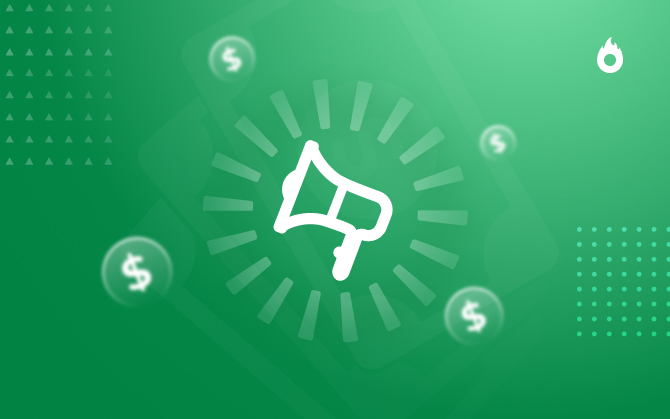
A Beginner’s Guide to Paid Advertising
Learn what the main advantages of paid advertising are and how to use them to boost your business.

What will we see in this post
In a perfect world, your business timeline would look like this: create company > create website/blog/social network > get dozens of followers > brand becomes a hit > make money.
Unfortunately, things are never that easy, and it takes a lot of time and effort to optimize your channels for conversion.
Sure, there are stories of people who started their companies and, in less than six months, became the new market leaders in their niche. But remember, they’re the exception, not the rule!
In this post we’ll show you how to use paid advertising to attract and convert customers.
But remember, paid advertising is not a substitute for SEO and quality content.
Paid advertising is a tool to attract your audience. You’re still responsible for converting, delighting, and, especially, monitoring the quality of the content you share.
So, keep reading to learn the basics of paid advertising, and how to optimize your ads in line with inbound marketing principles.
SEO versus paid advertising
The main purpose of search engines is to present users with the most relevant content for a given search term.
The top results for a given search are websites that best fit into search engine results criteria.
In the case of Google, there are more than 200 factors to rank a website based on the user experience.
Getting to the top positions of organic searches requires time, as well as effortful and consistent SEO work. In addition, you must constantly adapt your content to keep your website updated and relevant.
Building authority status on a given topic takes time, but paid advertising can help you save time while you work on your organic strategy.
VIDEO: PAID OR ORGANIC TRAFFIC: Which is BETTER if you’re just GETTING STARTED? | Hotmart Tips
Use the tools available to you
One of the main advantages of using paid advertising is the number of tools that can help you create and efficiently promote your ads.
Google AdWords is probably the most well-known among them.
To have access to AdWords, you only need to sign up to Google Partners, using your Google email account.
Then you’ll have access to a features and services dashboard. This will help you define not only your campaign’s keywords but also the daily budget, promotion frequency, location, and devices.
This doesn’t mean you don’t have to invest in qualified professionals to optimize your campaigns. But it does mean you can use free tools if you don’t have too much money to invest.
Define your target audience
If you’ve decided to invest in paid advertising, you’ll need to set a strategy to ensure your ad brings the right audience to your page or profile.
The first thing you’ll need to do is come up with your buyer persona.
If your business is just starting out, you may not have enough information to “create” your ideal customer.
If this is the case, carry out some research about your competition, talk to friends and people who have already purchased your product, and evaluate the main demographics of your market.
VIDEO: How to create a buyer persona for your business | Hotmart Tips
Choose a paid advertising campaign type
The choice of network to use to promote your campaign will depend on your strategy, the type of service you offer, and the format of your ad. Google, for example, offers several different types of campaigns.
Let’s take a look at some of the most common types of paid advertising:
Sponsored links
Sponsored links are the first results that appear on a search results page above the organic search results.
This type of campaign can be directed to your business’ target audience (using your persona), according to targeting tools offered by AdWords.
Remarketing
You know when you search for sneakers and then ads for sneakers keep appearing for you? That’s remarketing.
Remarketing is useful to reach people who have previously visited your website or search for a related product.
It’s a simple strategy and consists of basically repeating your ad on other pages (belonging to the same segment as yours), to remind your leads of your product or service.
Social media ads
Advertising on social media is like advertising on other websites. Ads targets people taking into account their profiles, the kind of content they interact with, share, and like.
Due to the wide range of social media networks (Facebook, Instagram, Twitter, YouTube, Snapchat, to mention a few), make sure to focus your efforts on the networks used by your audience.
Structuring your paid advertising campaign
Once you’re ready to start your campaign, write down all your ideas. Start thinking about possible teasers, information your ad must contain, who you want to attract, and how you’ll advertise.
When you’re ready to advertise, follow the steps below.
Prepare your ads
Think of what pieces you’ll advertise and where you’ll advertise them. These pieces will be shown on websites that are part of the same niche as yours, so, pay attention to the advertising that’s already running on these pages.
If advertising on social networking sites, pay attention to their rules regarding the size of ads, and the amount of text, among others, to avoid your ads being rejected.
Make sure you only use your own images or public domain images. Sites like Pexels and Shutterstock can help you find public domain images that you can use in your ads.
When writing your ad copy, use the data you collected during the other stages to speak the same language as your persona and really connect with your audience.
Remember: well-done paid advertising can influence buyers’ perception of your brand and you want their first contact with your brand to be positive.
View this post on Instagram
Set your budget
Your budget will depend on your goals and how much you’re willing to invest, whether you want to build brand awareness, gain followers, or increase sales.
If you’re just getting started with paid advertising, start with a low budget to see what works, and increase your investment as you figure things out.
Segment your audience
Some options to segment your audience include: keywords, location, user’s language, age, devices used.
Consider your target audience and use the right criteria to segment your ad to reach the right people.
Make sure to consider all the demographics of your audience, and, depending on what your advertising, their location.
Run your ad
Once you’ve prepared your ad pieces, defined your budget, and segmented your audience, you’re ready to run your ad!
Decide on the best type of campaign type and the optimal platform to advertise and set up your ad with your established budget.
Measure your paid advertising results
Once your ad is running, your work is far from over! Make sure to track your results to see if your ad is achieving your desired results and what you can improve upon.
Fortunately, most online advertising platforms provide lots of different metrics about campaigns. Take some time to look at the data and decide what worked or what didn’t work, and why.
If you track the metrics from all your campaigns, you’ll be able to optimize your ads and find the best ways to reach your target audience.
Last, but not least…
Don’t be influenced by people who were unsuccessful with paid ads.
And remember, you shouldn’t rely exclusively on paid advertising to promote your products. As previously mentioned, paid advertising should be a complement to your overall marketing strategy.
If you’d like to learn more about paid traffic in greater detail, be sure to check out this post.






